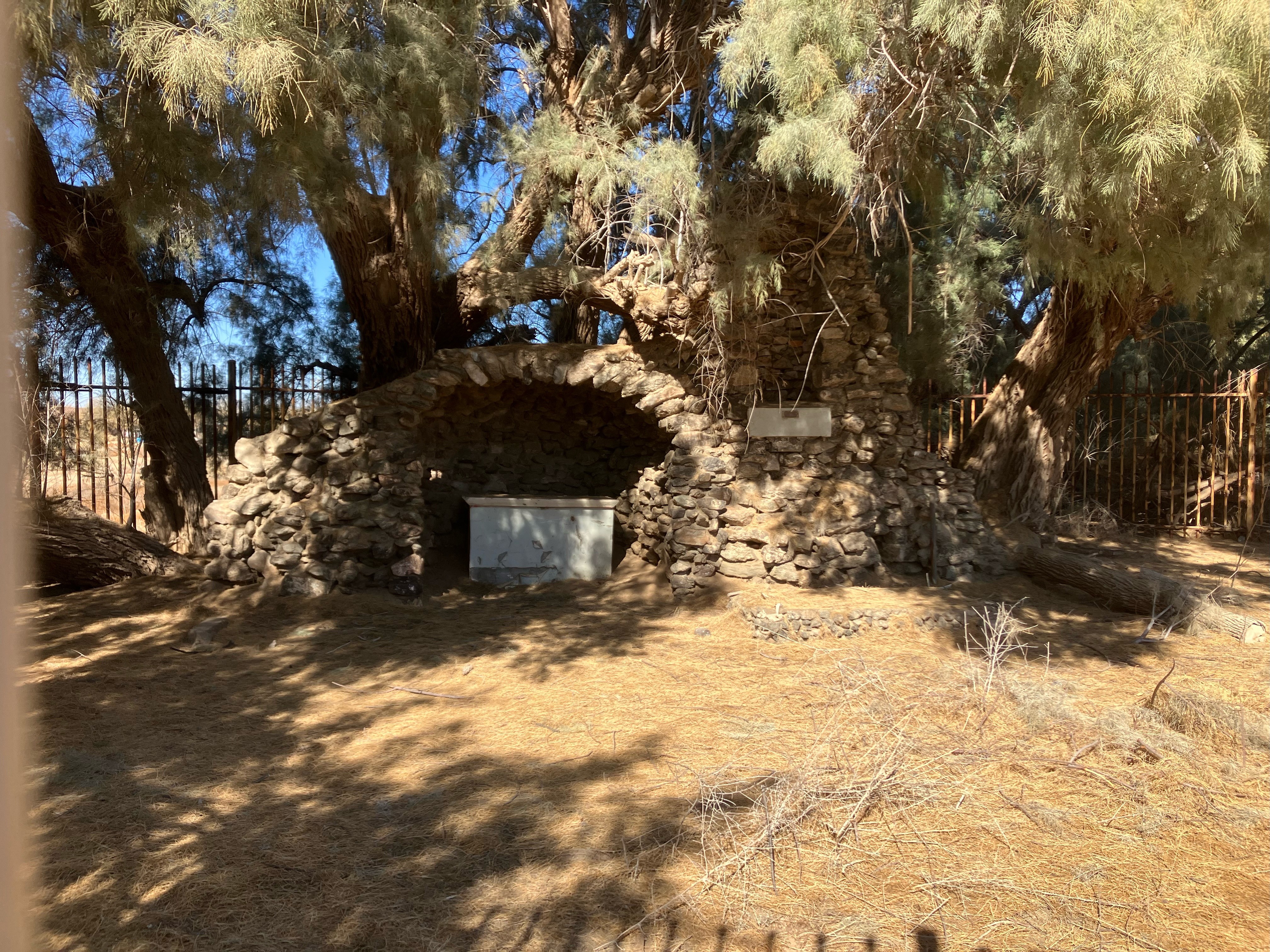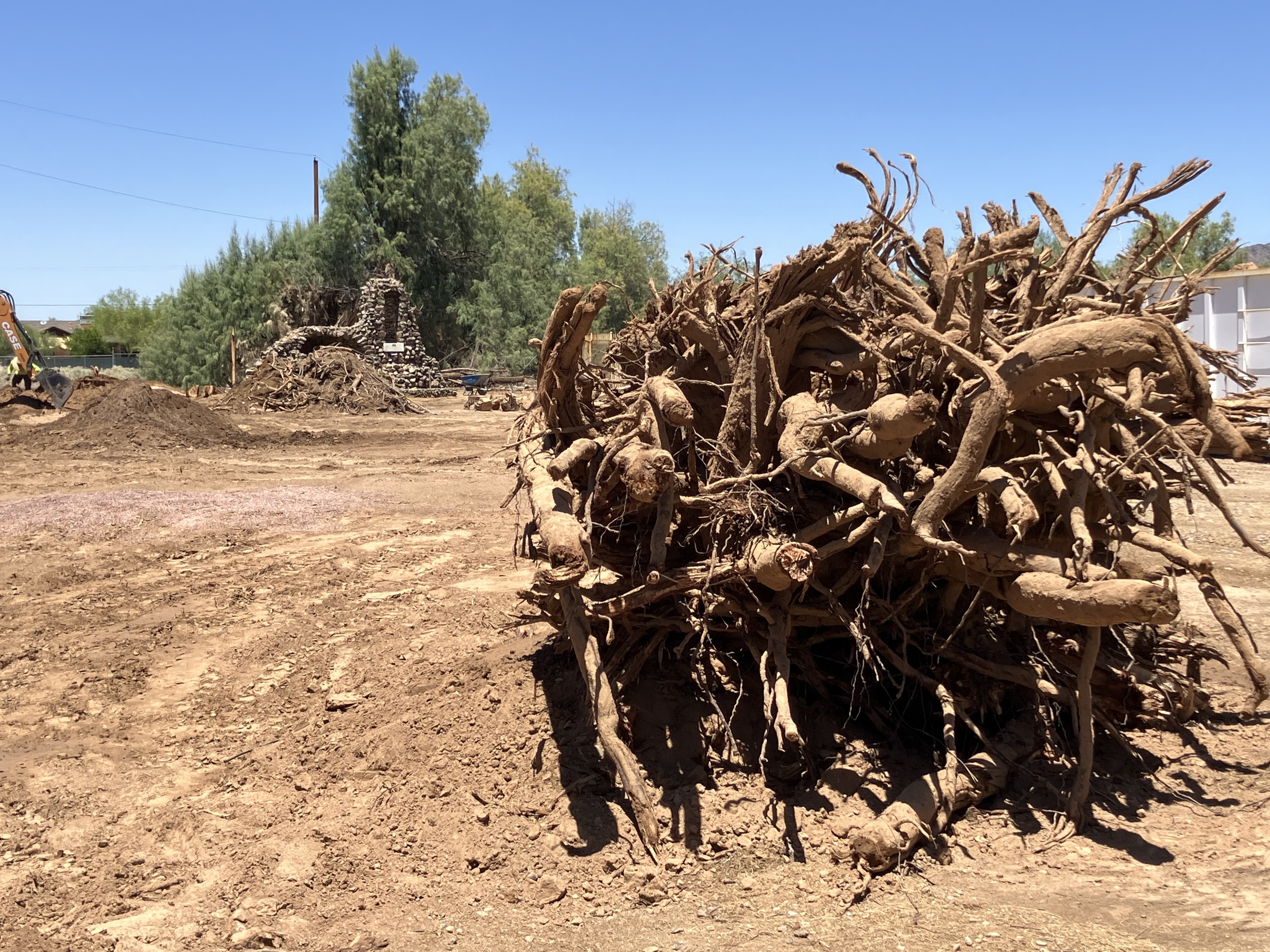
On summer days in the 1950s when Monica Domingo and Cornelia Garcia weren’t cooling off in the Gila River, they were helping the nuns at St. John’s Indian School varnish desks, getting them prepared for the school year. Domingo and Garcia were students who attended the school on the Gila River Reservation.
The nuns were part of a Franciscan religious order from Santa Barbara, Calif., and taught the 400 students who attended the school. The school went through 12th grade, made up of students from all different tribes. Priests from the same religious order provided access to the sacraments for the students and community members who attended St. John the Baptist Mission.
“We practically grew up with the nuns and the priests,” Garcia recounted. “It was a thriving school.”
Now, all that remains of the school is a dilapidated sign on the corner of Pecos Road and 51st Street that reads “St. John’s Indian School” along with foundations of old buildings. St. John the Baptist Mission still remains, and the old convent where the nuns used to live is now inhabited by the Franciscan Friars of the Holy Spirit who oversee the mission along with 10 other missions throughout the Diocese of Phoenix.
As Garcia said, St. John’s Indian School was thriving back in the day. One might say that it thrived because of a devotion to Mary that the religious sisters passed down to the students.
Domingo and Garcia’s memories of the school are entwined with memories of the Our Lady of Lourdes Grotto in the far corner of the property. The nuns dubbed them flower girls in May, where they’d wear white dresses and process with the rest of the school to the grotto, dropping flower petals along the way. One of the boys would climb up to the statue of Our Lady and place a crown of flowers on Mary’s head.
Domingo and Garcia have more memories of the grotto: praying the rosary there on holy days, processions to the grotto from the mission church for the feast of Corpus Christi and praying at the grotto during Lent and Holy Week.
“We were instructed to keep those holy days really holy,” Domingo said.
Domingo even remembered taking a picture for her eighth-grade prom in front of the grotto. The photo showed the little pond that was next to the grotto that the nuns would fill with fish during certain times of the year.
The nuns were tough, Garcia and Domingo said through tears of laughter.
“Sr. Mary Anne was tough but had a real kind heart,” Domingo said. “She used to buy us ice cream.”
“That made up for her meanness,” Garcia laughed.
The nuns taught the children how to pray. Garcia and Domingo remember kneeling on the ground at the grotto while praying the rosary.
“[The nuns] taught us everything,” Garcia said. “I still pray the rosary.”
That love for Mary was instilled in the students at a young age and it still shows. Domingo and Garcia, elders in the Gila River Community, are now in their 80s. When asked why Mary is so important to the Native culture, without hesitation, Garcia said, “[Mary] is our mother.”
There’s no documentation that shows why a grotto to Our Lady of Lourdes was built more than 100 years ago. Fr. Antony Tinker, community servant of the Franciscan Friars of the Holy Spirit, pointed out that Our Lady appeared to St. Bernadette in France in the 1850s and was approved as an apparition in 1862, which would fit with the timeline of the grotto being built in the early 1900s.
The Natives at the time may have recognized that Our Lady of Lourdes was the most recently approved apparition and felt a connection to her as the rest of the world did at this time.
“Our Lady [of Lourdes] brought forth a spring of water that you would dip in to receive healing. I think it really touches on the spirituality of our native people in their connection to nature,” Fr. Tinker said.
For Domingo, nature was a way of life on the reservation. Domingo remembered some of her family members from Mexico coming to the reservation to help farm. Before going out to the fields, they’d pray the rosary.
Farming is part of the culture of the Natives who live on the Gila River Reservation, who relied on the river for farming. Although the river was dammed up in the 1900s, the Natives are still known as The River People.
Domingo’s parents also attended St. John’s Indian School and eventually married.
Garcia moved to the area from Bapchule, Ariz., the other side of the reservation, when she was about five years old. She remembers meeting Domingo and her family in third or fourth grade.
“85 years later, and we’re still here,” Garcia said, laughing.
When Domingo and Garcia graduated in 1959, they didn’t know how quickly the grotto and the presence of the nuns and priests would become a distant memory. Garcia and Domingo both moved to Phoenix and were there for many years. It wasn’t until coming back to the reservation years later that they saw a fence around the grotto and heard that the school would be shut down, due to a lack of funds.
In the 1970s, the high school closed, and then 20 years later, the grade school closed and the priests and nuns left one by one.
Fr. Tinker explained that the land was returned to the tribe when the school shut down. In an effort to protect the grotto, it was fenced in, but over time it was forgotten about and left unattended. 
“It was all with good intention to protect [the grotto] from anything,” Fr. Tinker said. “At that time, it hadn’t really been used. It was … forgotten about. In fact, most people at the parish have no idea it was even there.”
The forgotten shrine is a visual representation of what the people of St. John Mission felt for many years after the school closed and the priests left. There was a diocesan priest who was assigned to the struggling mission for a few years. After he left in the 1980s, the Native people went without a priest assigned to them for 30 years.
“When the priests left us, we were still active,” Domingo recounted.
Domingo started leading prayer services every Sunday. A retired priest came once a month for Mass, consecrating enough hosts for Domingo to distribute during prayer services.
During those difficult years, parishioners never stopped praying for priests and in 2015, their prayers were answered when the Franciscan Friars of the Holy Spirit arrived.
“I was so glad when the priests came,” Domingo said. “I didn’t have to do [prayer services] anymore. It [was] not easy.”
Fr. Tinker is one of the founding members of the Franciscan Friars of the Holy Spirit who arrived in 2015. Upon arrival, he heard about the grotto from Domingo, Garcia and other elders.
“When I arrived here in 2015, the elders said, ‘We’d like our shrine back,’” Fr. Tinker recounted.
“There was this common memory of the people of these devotions they had during school. In our Catholic faith, we have these seeds [that] get planted within us … and those seeds can lie dormant for a little bit, but those seeds are still there, and they can sprout.
“Our elders … remember these devotions, and they planted seeds in their life that either kept them in the Catholic Church, or brought them back to the Catholic Church,” Fr. Tinker said.
Restoring the grotto has been in the back of Fr. Tinker’s mind ever since arriving in 2015. Back then, he quickly realized the extent of the project.
“I was like, this is a big project,” Fr. Tinker said. “This is not a quick, snap your finger to make it happen [project].”
It wasn’t until a few months ago that he started working on getting the grotto back and restoring it. He’s still wondering what prompted him to take the plunge. What he chalks it up to is inspiration from Our Lord and Our Lady.
“I was walking the property, praying my rosary, walked over to the shrine a few months ago … I just saw that area [and thought], this could be a really beautiful area.
“People really like being on the property … having a quiet place to pray, to turn to Mary. This is [Mary’s] mission. We’re her community. It’s her property.
“Seeing the shrine, [I thought], this could be really beautiful. The Lord spoke like, ‘It’s time to move. It’s time to make this happen.’ All I can say is, the Holy Spirit moves. Our Lady took over.”
Domingo remembered the day that Fr. Tinker told her that the shrine would be restored. “Finally, someone heard that we wanted to keep it,” Domingo said. “Somebody finally heard us.”
The first step was to get the land back, which Fr. Tinker was able to accomplish relatively quickly. Then the Gila River Police Department, which has a station adjacent to the grotto, helped clean up the area, removing overgrown foliage, branches and brush. The tribe also helped to clear out the brush between St. John’s property and the shrine.
The fence and tamarack trees that kept the grotto out of sight for decades were recently removed. Below the stumps intricate root systems were revealed, a visual representation of the decades that the grotto had been hidden, only waiting to become the prayerful presence it once was. 
Although the grotto has come a long way in only a few months, there’s still a lot to be done.
The foundation of the shrine needs to be restored and will be extended to make room for benches, providing space for personal prayer. The shrine itself will be repaired by resealing it and then putting a protective coating over top. Gravel will be added to the surrounding area along with a wheelchair accessible pathway for elders or those with walkers. There’s a hope of running electricity and water to the grotto to allow for nighttime events and gatherings. The area will be beautified and plants will be added for more privacy.
“Our Lady has guided us so far,” Fr. Tinker said. “[It’s] all in the Lord’s timing.”
The Tinker family owns a marble Marian statue that has been part of the family for a long time, which will likely be used for the grotto.
“The question is, what statue does [Mary] want to be there?” Fr. Tinker said. “If the Lord provides or Our Lady provides something different, we’ll put that up.”
After the grotto is dedicated, Fr. Tinker envisions it being used as a place for personal prayer, a place where holy days and Marian feasts can be celebrated like Domingo and Garcia remember and a place where a yearly festival can be celebrated.
“[There’s] a lot of excitement from the elders who remember it. Other people are in awe like, ‘This [Grotto’s] been here?’ Everyone’s supportive. It’s been really beautiful,” said Fr. Tinker.
“It’s kind of like the treasure hidden in a field. We really had the treasure hidden in the field, and we’re digging it up.”
The grotto will be dedicated after the restoration has been completed. To stay up to date, join our email list!
